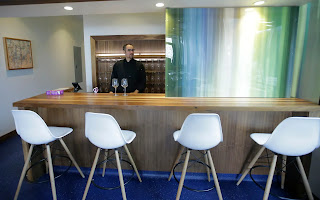“One raw jalapeño and a PBR tallboy, please.”
That was my recent order at Davanza’s, a “laid back bar and eatery” in downtown Park City. Or at least, my order as dictated to me by the helpful Davanza server.
This past weekend’s ski trip provided an impeccable opportunity to do some very thorough first-hand, real-world research into Utah’s quirky alcohol laws that we discussed last class.
As I
discovered, Davanza’s has a “Limited-Service Restaurant” alcohol license - which, among other restrictions, requires there to be food on the table before alcohol can be served. Hence one jalapeño.
Fortunately for Davanza’s, we proceeded to order very much pizza - as their LSR license also requires 70% of their revenue to come through the sale of food.
Unfortunately for me, my PBR was no typical PBR. This PBR, as indicated in fine print on the top of the can, was a lowly 4.0% ABV, a far cry from its usual 4.7%. According to Utah law, “beer” must have less than 3.2% alcohol-by-weight, or 4% ABV, and anything higher is even more strictly regulated. In the case of PBR, this means drinking 6 Utah beers for every 5 “standard” beers to achieve the intended effect, a challenge I readily accepted in the name of science.
Utah liquor laws have rapidly liberalized in the past few years. If we had visited prior to 2017, our drinks at restaurants like Davanza’s would have been prepared behind a “Zion curtain” - a 7-foot-high sheet of frosted glass that hides the ever-tempting alcohol from our debaucherous view.
This Zion curtain law was repealed in 2017, but replaced with a new law requiring establishments with a bar and restaurant in the same building to have them in different “rooms” - begging a definition of “room,” and prompting the awkward floor plans that we found at the High West “Distillery & Saloon” and Collie’s “Bar & Grill.”
Utah liquor laws are a Byzantine quagmire of prohibitions and comical loopholes. But they are hardly unique.
Walk through a Las Vegas casino, and you’ll find a wide walkway of colored carpet guiding you from one end of the casino floor to the other. Under-21-year-olds must remain on this carpet and cannot wander between the rows of tables and slot machines, and if they linger a bit too long they’ll be told to get a move on by a security guard.
Try to buy cigarettes in San Francisco, and you’ll find they’re locked up behind the counter, requiring a clerk’s help to access them.
Buy a 12-oz can of Coke in Berkeley, and you’re contributing an extra 12 cents to the general fund of the City of Berkeley, thanks to the “soda tax.”
Regulation in the name of public health is hardly unique to Utah, or to the alcohol industry. We know gambling is addictive. We know smoking causes cancer. We know sugary drinks lead to obesity and diabetes. And so we create regulations, some more misguided than others, to curb these harms for the greater good.
We have known of the negative effects of alcohol, or gambling, or tobacco for decades, if not millenia. But more recent inventions call into question our government’s role and ability to react to threats to public health.
As of recently, we now know Facebook
usage leads to depression. We now know
mobile game addiction is real, and can lead to
significant costs for those afflicted. We now know that phone notifications trigger a
dopamine feedback loop not unlike that created by the flashing lights of a slot machine, causing us to crave more.
Tech companies explicitly design their products to be addictive - or in tech terminology, to “maximize user engagement.” Indeed, there are only two types of product-sellers that refer to their customers as “users” - tech companies, and drug dealers.
Yet unlike drug dealers, or alcohol companies, or tobacco companies, these tech giants can run thousands of experiments a day, tweaking features in real-time to maximize this addiction, and personalize the appeal of their product to each individual user. The power of A/B tests and machine learning to create addiction far outstrips the ability of our human brain to adapt to and discount these new stimuli. Where gambling may take our wallets, alcohol may take our livers, smoking may take our lungs - consumer tech may be taking our minds.
There is a lot we can learn from effective - and ineffective - regulation of the alcohol industry to apply to emerging new industries that pose a threat to public health. Will we see small-but-steady curbs to the worst excesses, designed by knowledgeable insiders? Or will we see a sea-change backlash to tech’s influence on life and democracy, followed by a tech version of Prohibition?
I vote, at the very least, that you should have to eat a raw jalapeño before you can send your spicy take of a Tweet.












